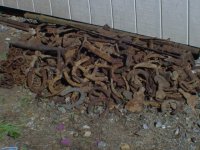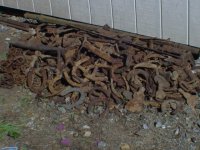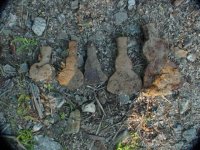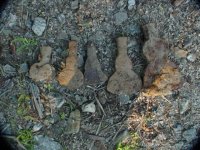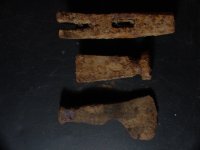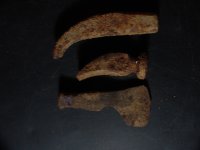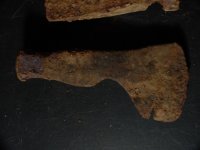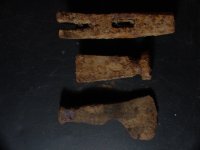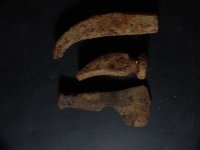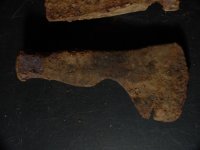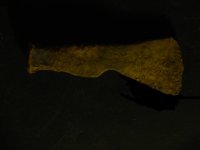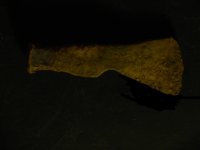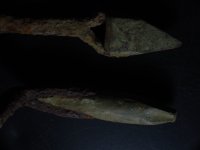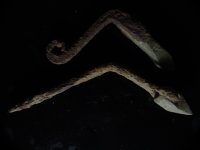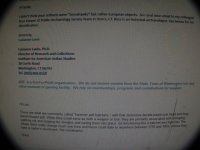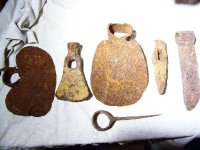The pile is getting out of control and I'm thinking of moving it. I should take pictures of the different pieces,some individual and some as a collective and make an updated post. What do ya think, a scrap shoot updated picture now and then?....HH.... 401K
You are using an out of date browser. It may not display this or other websites correctly.
You should upgrade or use an alternative browser.
You should upgrade or use an alternative browser.
Scrap Shoot
- Thread starter 401K
- Start date
with the scrap prices up i could buy some batteries. I'm sure there are some old tools around. What shingle hatchet do you refer to? These are trade axes used in trade with the Indians.del link=topic=10562.msg116383#msg116383 date=1341870641 said:time to sell some scrap iron lol lol any old tools besides the shingle hatchet in there ??
Attachments
del
Administrator
got a better picture of the one right in the middle (the one thats different than the rest) it pretty interesting the others are shingle hatchets and are quite common to find at old cellar sites . trade axes in the new england area had a distinct look about them then they looked more like tomahawks in the mid-west.
heres a great link to trade axes .
http://furtradetomahawks.tripod.com/id25.html
Dan
heres a great link to trade axes .
http://furtradetomahawks.tripod.com/id25.html
Dan
ya the plains type are the most common ones known but the early colonial type are like the ones i have. if you look at the link you posted you will see that there are ones similar to the ones i have.these ones are the earlier type than what you are thinking of. there were many blacksmiths in the colonial days that made them and the Indians liked them. the shingle hatchets are different and have a v like notch in them. got to go now and hope the ID of these will come to lite. will be back in a few hrs.del link=topic=10562.msg116389#msg116389 date=1341875193 said:got a better picture of the one right in the middle (the one thats different than the rest) it pretty interesting the others are shingle hatchets and are quite common to find at old cellar sites . trade axes in the new england area had a distinct look about them then they looked more like tomahawks in the mid-west.
heres a great link to trade axes .
http://furtradetomahawks.tripod.com/id25.html
Dan
del
Administrator
not all had the ever so common notched out V in the head , i'm referring more to the traditionally shaped style to the hatchet itself and they are known as shingling hatchets . true they may have been traded with indians (most anything was as some point ) , indians didn't use nails in the normal sense as the colonials so they didn't really need a hatchet with a hammer head on it . this info on early native indians has come to me from a few different reliable sources , nails were used more as drills , to poke through leather or other soft material or even to make fish hooks but they did not use them like they were intended by the blacksmith who made them . after all they didn't nail their huts or wigwams together  .
.
heres another site that shows some axes scroll down and you'll see your type (no V-notch) thats clearly labeled as 18th century shingling hatchet.
http://www.fs.fed.us/eng/pubs/htmlpubs/htm99232823/page02.htm
Dan
heres another site that shows some axes scroll down and you'll see your type (no V-notch) thats clearly labeled as 18th century shingling hatchet.
http://www.fs.fed.us/eng/pubs/htmlpubs/htm99232823/page02.htm
Dan
here is page 12 of your link that you posted dan. Thanks! http://www.google.com/url?sa=t&rct=j&q=polled%20tomahawk&source=web&cd=2&ved=0CFAQFjAB&url=http%3A%2F%2Ffurtradetomahawks.tripod.com%2Fid19.html&ei=G477T7moNer50gG7w4nrBg&usg=AFQjCNEyEVdZb1Mq9hJQ4S-S79Ljf-Dymw&cad=rja
nails or no nails the thing is still a hand tool that could have been used to crack nuts. and thanks for the link, you should check out page12 Thanks again!!del link=topic=10562.msg116392#msg116392 date=1341880195 said:not all had the ever so common notched out V in the head , i'm referring more to the traditionally shaped style to the hatchet itself and they are known as shingling hatchets . true they may have been traded with indians (most anything was as some point ) , indians didn't use nails in the normal sense as the colonials so they didn't really need a hatchet with a hammer head on it . this info on early native indians has come to me from a few different reliable sources , nails were used more as drills , to poke through leather or other soft material or even to make fish hooks but they did not use them like they were intended by the blacksmith who made them . after all they didn't nail their huts or wigwams together.
heres another site that shows some axes scroll down and you'll see your type (no V-notch) thats clearly labeled as 18th century shingling hatchet.
http://www.fs.fed.us/eng/pubs/htmlpubs/htm99232823/page02.htm
Dan
For sure and certain it was made by a blacksmith, whether called a belt axe, trade axe,iron hunters tomahawk, they was probably made in the 1700s as a white mans belt axe. I think that they were made around the mid to late 1700s and were traded with the Indians. I only call it a trade axe because a very good friend that is well studied in the native Indians agrees that it's a trade axe, same as an American Indian historian from the museum at Foxwoods or the SUN would probably also agree that the Indians would have traded. I guess it's just one of those things that gets it's name from whatever the purpose of it's use at the time was.Thanks for the links and for the time! So the thing is what the white man called a belt axe in it's day and the Indians called it a tomahawk. Thanks again ....HH.... 401Kdel link=topic=10562.msg116392#msg116392 date=1341880195 said:not all had the ever so common notched out V in the head , i'm referring more to the traditionally shaped style to the hatchet itself and they are known as shingling hatchets . true they may have been traded with indians (most anything was as some point ) , indians didn't use nails in the normal sense as the colonials so they didn't really need a hatchet with a hammer head on it . this info on early native indians has come to me from a few different reliable sources , nails were used more as drills , to poke through leather or other soft material or even to make fish hooks but they did not use them like they were intended by the blacksmith who made them . after all they didn't nail their huts or wigwams together.
heres another site that shows some axes scroll down and you'll see your type (no V-notch) thats clearly labeled as 18th century shingling hatchet.
http://www.fs.fed.us/eng/pubs/htmlpubs/htm99232823/page02.htm
Dan
del
Administrator
well after reading Pg. 13 i'm still not convinced as it would seem that those are the most commonly mistaken types of axes and what makes it worse is the fact they were still being manufactured well into the 1900's . i myself love the old hand wrought iron tools and its just a shame to see them (especially if they were trade axes) sitting in a pile of junk like that and not in a display or hung on a wall or even restored. HH
Dan
Dan
this might help you with the understanding of tomahawks http://tatcalite.tripod.com/id42.htm Del lets just say that if I were recovering relics for a tribe of Indians and I found one of these trade axes and threw it in the scrap pile, I don't think that that would look to good on my resumé.del link=topic=10562.msg116447#msg116447 date=1341919897 said:well after reading Pg. 13 i'm still not convinced as it would seem that those are the most commonly mistaken types of axes and what makes it worse is the fact they were still being manufactured well into the 1900's . i myself love the old hand wrought iron tools and its just a shame to see them (especially if they were trade axes) sitting in a pile of junk like that and not in a display or hung on a wall or even restored. HH
Dan
del
Administrator
401K link=topic=10562.msg116465#msg116465 date=1341937474 said:Del lets just say that if I were recovering relics for a tribe of Indians and I found one of these trade axes and threw it in the scrap pile, I don't think that that would look to good on my resumé.
your right about that Scott , hey by the way who is your knowledgeable friend maybe i know him or he knows the anthropology professors or archaeologists i'm in contact with ??
Dan
del here are some American hammer poll belt axes,{ http://tatcalite.tripod.com/1299db770.jpg } some different styles, and the ones that I find around here are similar to one in the picture. All of the ones in this picture are presented as being traded with the Indians. These are NOT shingle hatchets in origin they are called belt axe or poll belt axe by the white man who made them and tomahawks by the Indian,and they were traded with the Indians. The ones in the picture are authentic trade axes. There are people that have more knowledge in the trade axe field and write books about the subject and it seems to me that this site is familiar with those books and the people that wrote them. If you come in contact with your professors please have them check out the site. It sounds to me that you do not think that these are trade axes and you think that they are shingle hatchets. One of us are wrong and all that I have seen leads me to believe that they are trade axes to the Indians. I hope all is good and we find out if the American Indian would have traded for a belt axe. ....HH.... Scott .......... If you like I could send a picture to one or all of your professors, so if you get their email please PM me the address. Thanks
OK first update Here are some old tools- hammer heads and an 1800s shingling hatchet head. I will find more in the pile.del link=topic=10562.msg116383#msg116383 date=1341870641 said:time to sell some scrap iron lol lol any old tools besides the shingle hatchet in there ??
Attachments
Dan after more research I think that the axes that I found are hammer polled axes and there is a difference between a trade axe and a hammer poll axe even though both were traded with the Indians and were used as tomahawks. Charles Hanson one of the founders (Museum of the Fur Trade) with a special emphasis on trade goods { http://www.google.com/url?sa=t&rct=j&q=charles%20hanson%20tomahawk&source=web&cd=4&sqi=2&ved=0CFEQFjAD&url=http%3A%2F%2Fwww.historyaccess.com%2Fmuseumofthefurtr.html&ei=pJz_T4e5BKPm0QG-9JW-Bw&usg=AFQjCNHa98yklwJZxlITcY28KSsxkqvk5A&cad=rja } refers to the type of axe that I found as a 18th C. iron hunters tomahawk and used by the white people as what they call today hammer poll belt axe. So a trade axe is more like the squaw axe type than the hammer poll type. I still do not believe that they were shingling axes. The author of TD publications ( An Ax to Grind: A Practical Ax Manual ) { http://www.fs.fed.us/eng/pubs/htmlpubs/htm99232823/page02.htm } Bernie Weisgerber { http://www.fs.fed.us/eng/pubs/htmlpubs/htm99232823/page07.htm }who referred to them as shingling axes I feel did not have as much expertise in the field of early belt axes as Charles Hanson seeing Bernie was a forest ranger and a carpenter nothing to do with founding a museum like Charles Hanson. That is why I do not believe that these are shingling hatchets. I think we were both wrong. Thanks for helping me make the discovery so both of us can hopefully benefit. It would be correct to call them a tomahawk but who knows who lost them, Indian or white? Hope all is well!! ....HH.... Scott
Thanks Dan Here is an email I received that agrees with what you said.del link=topic=10562.msg116383#msg116383 date=1341870641 said:time to sell some scrap iron lol lol any old tools besides the shingle hatchet in there ??
Attachments
del
Administrator
hey Scott what other tools do you happen to find or collect ??
heres just a selection of some others besides the axes and hooks and chains . from left to right are the common garden hoe , an adz , a heavy duty mattox , a small blacksmith hammer and somekind of short bladed harvesting cutter , the bottom spike is really a handle fitting for a large scythe ( the two wooden handles have this iron bracket that holds them onto the main shaft).
Dan
heres just a selection of some others besides the axes and hooks and chains . from left to right are the common garden hoe , an adz , a heavy duty mattox , a small blacksmith hammer and somekind of short bladed harvesting cutter , the bottom spike is really a handle fitting for a large scythe ( the two wooden handles have this iron bracket that holds them onto the main shaft).
Dan
